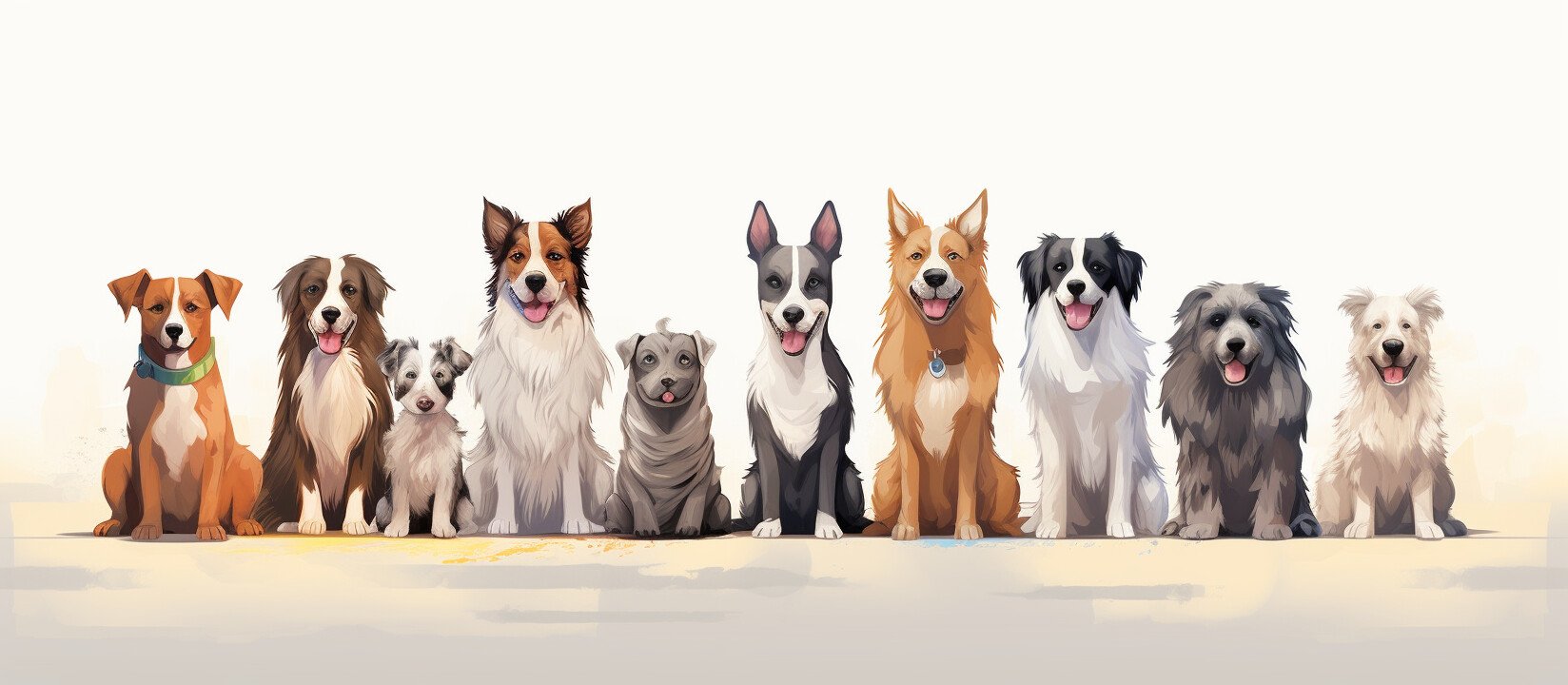60. Subtype polymorphism#
Have you ever considered how we naturally categorize things in our everyday lives? We see a dog and a cat and, while acknowledging their differences, we recognize that they both belong to a larger category, namely animals. We look at a collection of numbers and intuitively understand that each of them is an instance of a number, whether they are whole or decimal numbers.
Important
Subtype polymorphism is one of the most important ideas in object oriented programming.
This concept of generalization - grouping different things based on shared characteristics - is also prevalent in programming. In the world of object-oriented programming, this concept is known as ‘subtype polymorphism.’

Fig. 60.1 Just like different breeds of dogs all share the common type ‘Dog’, objects of different subtypes can share a common supertype in subtype polymorphism.#
This principle is not just natural; it’s also extremely practical. Consider, for example, balls that bounce. Whether it’s a basketball, a soccer ball, or a tennis ball, they all can be dropped and will all bounce. Each type of ball bounces differently due to its size and construction, but the essential characteristic remains the same: they can all be dropped and bounced.
In fact, the action of dropping the ball can be defined without any knowledge about which particular ball we are dropping. That’s because they are all balls – they share certain behaviors and characteristics. Whether we call this shared characteristic being a ball, bounciness, or droppable doesn’t matter. Unifying types with different behavior but a identical interface is what enables subtype polymorphism.

Fig. 60.2 Just like different types of balls share the common characteristic of ‘bounciness’, objects of different subtypes can share a common behavior in subtype polymorphism.#
In terms of terminology we call the more general type (like Animal) a ‘supertype’ and the more specific type a ‘subtype’.
Note
The terms ‘parent type’ and ‘base type’ are synonyms of the term ‘supertype’. The terms ‘child type’ and ‘derived type’ are synonyms of the term ‘subtype’.
Subtype polymorphism is a powerful concept because it allows us to write code that works with objects of the supertype, but it can also handle any subtype thereof. That’s because objects of a subtype can be treated as objects of the supertype. This property is known as ‘substitutability’ - an object of a subtype can be substituted wherever an object of the supertype is expected. Substitutability, and its dangers, will be discussed in more detail in the chapter on Liskov’s Substitution Principle.
So, how do we declare one type a subtype of another type? In object oriented languages, there are usually two ways of establishing a subtype relationship.
If type A implements the interface defined by type B then A is considered a subtype of B. If type A inherits from the class or abstract class B then A is a subtype of B.
Inheritance will be explored in future chapters, so let’s use interfaces for our examples.
Let’s consider an example where we have an interface called IShape and two classes Rectangle and Ellipse that implement it.
Show code cell source
interface IShape
{
double Width { get; set; }
double Height { get; set; }
double Area { get; }
}
Show code cell source
class Rectangle : IShape
{
public double Width { get; set; }
public double Height { get; set; }
public double Area => Width * Height;
}
Show code cell source
class Ellipse : IShape
{
public double Width { get; set; }
public double Height { get; set; }
public double Area
=> Math.PI * Width / 2 * Height / 2;
}
IShape shape1 = new Rectangle { Width = 10, Height = 5 };
IShape shape2 = new Ellipse { Width = 6, Height = 4 };
Here, shape1 and shape2 are variables of type IShape, but they hold instances of Rectangle and Ellipse, respectively. This is possible because Rectangle and Ellipse are subtypes of IShape. Even though the variables are of the supertype IShape, they can hold instances of any subtype.
The power of subtype polymorphism is truly realized when we perform operations on these objects.
Consider a simple local function called Scale that scales the width and height of any IShape by a given factor:
void Scale(IShape shape, double factor)
{
shape.Width *= factor;
shape.Height *= factor;
}
Note how Scale does not need to know anything about the specific type of IShape it is working with. It’s not concerned with whether the shape is a Rectangle or an Ellipse or any other shape - all it cares about is that it has a Width and Height that it can scale.
We can now create a Rectangle and an Ellipse, and use Scale to adjust their sizes:
IShape shape1 = new Rectangle { Width = 10, Height = 5 };
IShape shape2 = new Ellipse { Width = 6, Height = 4 };
Scale(shape1, 2);
Scale(shape2, 2);
Regardless of the shape type, Scale works perfectly because of the subtype polymorphism offered by the IShape interface. Even though shape1 is actually a Rectangle and shape2 is an Ellipse, Scale can still operate on them because they are both IShape.
After scaling, we can then calculate and output their areas:
Console.WriteLine(shape1.Area);
Console.WriteLine(shape2.Area);
200
75.39822368615503
Important
Not only does the method Scale work for all current implementations of our interface IShape, but it will also work for all future implementations of the interface. We can keep adding new classes that implement the interface and the method will be able to operate on objects of these types without us having to write any additional code.
This illustrates the power and flexibility of subtype polymorphism. By treating different types as their common supertype, we can write more generic and reusable code.
Note
Subtype polymorphism is sometimes also called ‘inclusion polymorphism’. This refers to the idea that from the perspective of set theory, subtype (like Rectangle) and a supertype (like IShape) can be thought of as a subset and a superset. This means that the superset ‘includes’ all members of the subset.
Practically, a variable of type IShape can contain objects of type Rectangle as well as objects of type Ellipse.
Note
The term ‘polymorphism’ comes from Greek, where ‘poly’ means many and ‘morph’ means form. So, polymorphism refers to the ability of something to take many forms. When someone says ‘polymorphism’ in the context of object oriented programming then they are most likely referring to subtype polymorphism. There are however other forms of polymorphism such as parametric polymorphism.
By adopting subtype polymorphism, we can start developing more abstract and higher-level thinking in our programs, dealing with broad categories like ‘shapes’ or ‘pets,’ rather than getting caught in the specifics of rectangles, ovals, dogs, or cats. In later chapters, we’ll explore how this principle can be applied even more extensively to design flexible and powerful object-oriented systems.